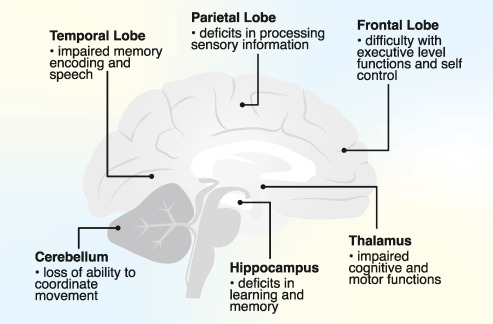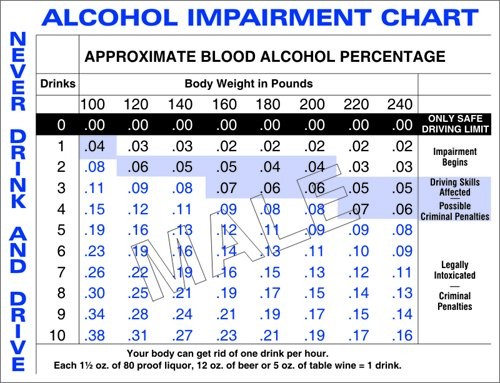Alcohol Problems
Short-Term & Long-Term Effects of Alcohol
.webp)
File photo. Credit: NDTV Food Alcohol affects every organ system in the body.
|
Alcohol in the Brain and the Nervous System
Alcohol diffuses readily into the brain, and because a small amount is absorbed from the mouth directly into circulating blood, its effects can be almost immediate, reaching the brain in as little as one minute after consumption.
Alcohol can produce detectable impairments in memory after only a few drinks and, as the amount of alcohol increases, so does the degree of impairment.
Large quantities of alcohol, especially when consumed quickly and on an empty stomach, can produce a blackout, that is, an interval of time for which the intoxicated person cannot recall key details of events, or even entire events. Figure X-1 shows the effects alcohol has on the brain.
 Figure X1. Effects of alcohol on the brain. As blood alcohol concentration rises, different parts of the brain are affected.
Figure X1. Effects of alcohol on the brain. As blood alcohol concentration rises, different parts of the brain are affected. |
Because alcohol is soluble in fat, it can easily cross the protective fatty memberane of nerve cells. There, it disrupts the brain’s complex system for communicating between nerve cells. Neurotransmitters that excite nerve cells and those that inhibit nerve cells are thrown out of balance.
Excess of some neurotransmitters produces sleepiness; high levels of others cause a loss of coordination; an imbalancne of others impairs judgment and mental ability; and still other neurotransmitters perpetuate the desire to keep drinking, even when it’s clearly time to stop. Changes in these messengers are suspected of leading to addictionOpens in new window and symptoms of alcohol withdrawal. In the short run, they probably contribute to a hangover.
Alcohol’s short-term effects are related to how much a person drinks. One or two drinks typically bring alcohol blood levels to 0.04 percent and usually cause only mild, pleasant changes in mood and release of inhibitions. With more drinks and rising blood alcohol levels, coordination, judgment, reaction time, and vision are increasingly impaired.
In the United States and Canada, it is illegal for a person whose blood level of alcohol has reached or exceeds 0.08 percent to drive a motor vehicle.
A review of 112 studies concludes that certain skills required to drive a motor vehicle can become significantly impaired at a blood alcohol concentration as low as 0.05 percent. For commercial drivers, a BAC of 0.04 percent is illegal nationwide. Table X-1 shows the effects various amounts of alcohol have on mood and behavior.

Source: University of Wisconsin Center for Health Sciences, 1988, and U.S. Dept. of Transportation, National Highway Traffic Safety Administration, 1992.
|
One possible acute effect of a large alcohol intake is hypoglycemia (low blood glucose), one of the most common and dangerous effects of abusing alcohol. Binge drinking, especially following several days of little food, also can be deadly.
The lack of food depletes glycogen stores, and heavy drinking suppresses gluconeogenesis. The resulting severe hypoglycemia is a medical emergency with the potential for coma and death.
A person who drinks heavily over a long period of time may have brain deficits that persist well after he or she achieves sobriety.
Exactly how alcohol affects the brain and the likelihood of reversing the impact of heavy drinking on the brain remain hot topics in alcohol research today.
Chronic alcoholism produces many different mental disorders. Malnutrition is a probable factor in most of these, even when diet appears adequate. After years of drinking, brain cells become permanently damaged and are unable to metabolize nutrients properly.
Alcohol’s Effect on the Gastrointestinal System
Years of heavy drinking and ongoing contact with alcohol and acetaldehyde eventually damage the gastrointestinal system, which, in turn, discourages eating, affects absorption of protective nutrients, and leaves the digestive lining even more vulnerable to damage as the vicious cycle continues.
Chronic irritation from alcohol and acetaldehyde erodes protective mucosal linings, causing inflammation and release of destructive free radicals. Esophagitis (inflammation of the esophagus), esophageal stricture (closing), and swallowing difficulties are common among alcoholics.
When the stomach is exposed repeatedly to alcohol at high concentrations, gastritis (inflammation of the stomach) often develops. Alcoholics frequently have diarrhea and malabsorption, evidence of intestinal damage. Cancer of the upper aerodigestive tract (mouth, pharynx, esophagus to larynx) is common, and consumption of both alcohol and cigarettes further increases the risk of these types of cancers.
Alcohol and the Liver
Metabolizing and detoxifying alcohol is almost entirely the responsibility of the liver. So it’s not surprising that too much drinking hurts the liver more than any other site in the body. In the United States, heavy alcohol use is considered the most important risk factor for chronic liver disease. According to the Centers for Disease Control and Prevention, over 29,000 people die annually in the United States as a result of chronic liver disease and cirrhosis (nearly 10 deaths per 100,000).
The earliest evidence of liver damage is fat accumulation, which can appear after only a few days of heavy drinking. Fatty liver recedes with abstinence but persists with continued drinking.
Is fatty liver in and of itself harmful? The answer is controversial among liver researchers, with some experts suggesting it’s a benign condition. However, studies show that 5 to 15 percent of people with alcoholic fatty liver who continue to drink develop liver fibrosis (excessive fibrous tissue) or cirrhosis (scarring) in as soon as 5 to 10 years.
Fat accumulation is one of several factors resulting in alcoholic liver disease. With regular, high intakes of alcohol, alcohol and acetaldehyde continually irritate and inflame the liver, producing alcoholic hepatitis (persistent inflammation of the liver) in 10 to 35 percent of heavy drinkers. The inflammatory process also generates free radicals that batter away at liver cells.
The destruction of liver cells becomes self-perpetuating, especially if antioxidant nutrients are unavailable to help break the cycle. If the intestines also have been damaged, toxins, including those produced by the gut’s microorganisms, can cross the intestinal barrier into circulation, worsening inflammation.
Alcoholic hepatitis may be treatable, but it’s often fatal. Alcoholic hepatitis also predisposes a person to liver cancer and cirrhosis, conditions that are usually fatal. With continued inflammation, the liver makes excessive collagen and becomes fibrous (fibrotic liver disease) and scarred (cirrhosis). This ultimately kills liver cells by choking off tiny blood vessels that nourish them. About 10 to 20 percent of heavy drinkers develop cirrhosis.
Dietary changes may be helpful in treating liver disease, but abstinence from alcohol is essential. Reducing dietary fats somewhat reduces fat accumulation in the liver. Consuming adequate micronutrients and a healthful balance of macronutrients probably speeds recuperation from liver diseases in their earlier stages. In late-stage liver diseases, dietary restrictions, often of proteins, may slow disease progression or improve symptoms.
See also:

